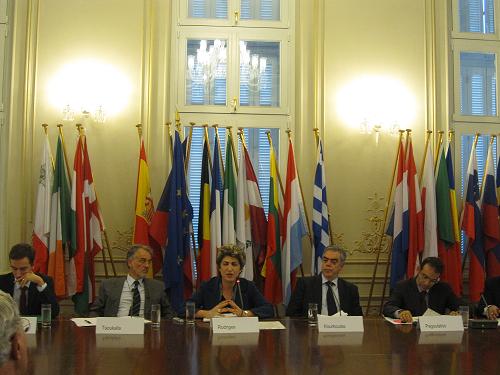Dealing with a crisis requires a two step approach: Managing daily the short-term issues that require immediate responses and envisioning a long-term strategy for the day after. In the case of the Eurozone crisis the long-term question is fundamental; what is the future of the EU and what kind of Union do we want to be in 2020? Contributing to this discussion, the Hellenic Foundation for European and Foreign Policy (ELIAMEP), the Athens University of Economics and Business, and the Friedrich–Ebert-Stiftung Athens, organised on the 2nd November 2012 at the European Parliament Office in Athens, a public debate on ‘Scenarios for the Eurozone 2020: Crash or a way out of the crisis?’
A special crisis
Any contemplation about the future of the Union should be based on two elements. First, the understanding that this is a particular and advanced kind of crisis because the European Union is, today, the most advanced model of supranational governance. Fundamentally, this means that any solution to the crisis requires a lot of historical creativity and more importantly, is a question of political choices. Secondly, that even if any given solution passes through Greece, the crisis is deeply European. It has revealed a systemic problem in the eurozone and it can only be resolved at the European level; to provide a positive solution the EU will need stronger institutions and significant deepening.
Yet, when contemplating about the future of Europe in 2020 all scenarios have to be elaborated and their consequences considered, whether these refer to disintegration or the formation of a genuine EMU as divergences between states are translated as negative opinion trends undermining the political support to european integration.
Four scenarios about Europe in 2020
a) ‘Muddling through’ – Practically, this is where we are today, attempting to resolve long-term problems with short-term solutions muddling around the institutional framework. While initially this strategy appears to be effective, in the course of events it is likely to lead to a single-market with huge disparities between member-states.
b) Break-up of the eurozone – This is the worst scenario, where the possibility of a default and exit of some countries will lead to the fragmentation of the eurozone and will put at stake the integration project. Nevertheless, this scenario is unlikely as the political will is clearly directed to retaining the political integrity of the Union.
c) Two-speed vs two-level Union – This is a relatively complicated situation. Effectively we are already facing the first case. A two-speed union is unavoidable as for example the economies of member-states differ and not all member-states are in the Eurozone. However, a two-level union where only a core-group of states proceeds towards a fully-fledged Union, is unacceptable as it would deter the process of integration and the European project overall.
d) A genuine EMU – This is the most optimistic and, possibly, the only scenario that presents a genuine long-term solution to the crisis. In this case, the basis is to create the conditions for all member-states to return to growth ensuring their fiscal consolidation and full-decision making capacities. An integrated banking system, stronger European institutions and a stronger EU budget are prerequisites for this scenario to be realized. Effectively this would mean a significant pulling of sovereignties and stronger European supervision over national systems including stronger macroeconomic and fiscal surveillance.
While scenarios do help to extrapolate trends, they don’t have a linear course. While on the one hand what seems today to be keeping the Eurozone intact is the realization that the cost of a possible break-up is very high, the road to the realization of a genuine EMU is basically political, as it raises significant questions regarding the democratic legitimacy of such a prospect where further integration must be accompanied by a genuinely democratic union.
Click here to watch the event.




